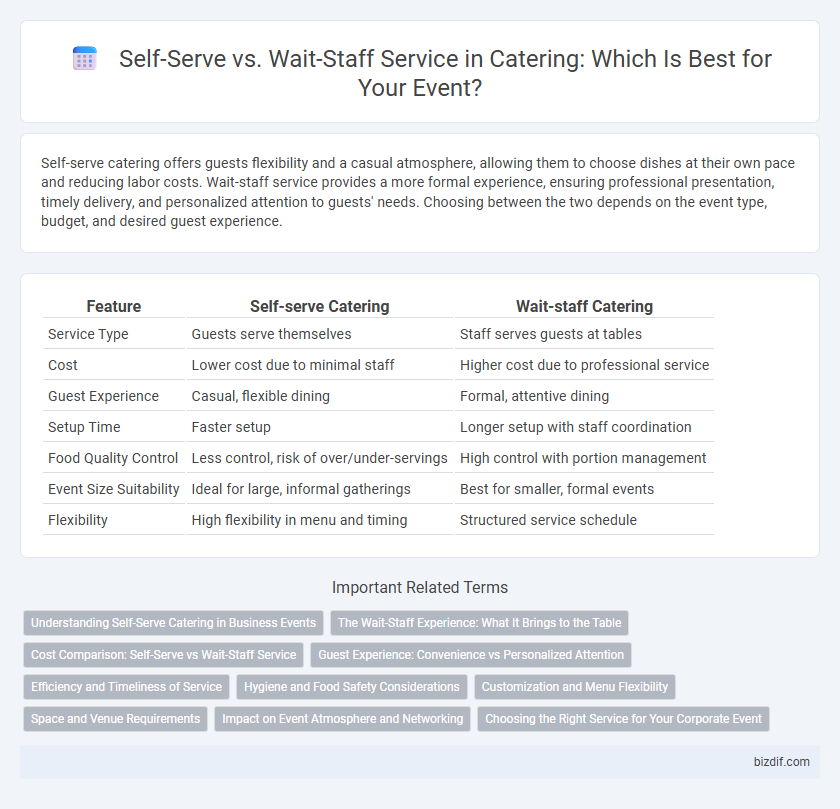Self-serve catering offers guests flexibility and a casual atmosphere, allowing them to choose dishes at their own pace and reducing labor costs. Wait-staff service provides a more formal experience, ensuring professional presentation, timely delivery, and personalized attention to guests' needs. Choosing between the two depends on the event type, budget, and desired guest experience.
Table of Comparison
| Feature | Self-serve Catering | Wait-staff Catering |
|---|---|---|
| Service Type | Guests serve themselves | Staff serves guests at tables |
| Cost | Lower cost due to minimal staff | Higher cost due to professional service |
| Guest Experience | Casual, flexible dining | Formal, attentive dining |
| Setup Time | Faster setup | Longer setup with staff coordination |
| Food Quality Control | Less control, risk of over/under-servings | High control with portion management |
| Event Size Suitability | Ideal for large, informal gatherings | Best for smaller, formal events |
| Flexibility | High flexibility in menu and timing | Structured service schedule |
Understanding Self-Serve Catering in Business Events
Self-serve catering in business events enhances efficiency by allowing guests to choose food at their own pace, reducing wait times and staffing costs. It promotes a casual atmosphere conducive to networking while offering a variety of customizable menu options that accommodate diverse dietary preferences. Implementing self-serve stations with clear signage and high-quality presentation ensures a seamless experience and maintains professionalism.
The Wait-Staff Experience: What It Brings to the Table
Wait-staff service enhances the catering experience by providing personalized attention, efficient coordination, and professional presentation that self-serve options lack. Trained servers ensure timely delivery, accommodate special requests, and maintain the event's flow, elevating guest satisfaction and event ambiance. This level of service supports complex menus and high-end events, making it ideal for formal occasions where detail and finesse are paramount.
Cost Comparison: Self-Serve vs Wait-Staff Service
Self-serve catering typically reduces labor costs by eliminating the need for wait-staff, making it a cost-effective option for budget-conscious events. Wait-staff service, while more expensive due to wages and tips, enhances guest experience through personalized attention and efficient table service. Businesses must weigh labor expenses against service quality when choosing between self-serve and wait-staff catering to optimize overall event costs.
Guest Experience: Convenience vs Personalized Attention
Self-serve catering enhances guest convenience by allowing individuals to choose their preferred dishes and control their dining pace, promoting a relaxed, informal atmosphere. Wait-staff service delivers personalized attention, offering tailored menu guidance and timely serving that elevate the overall dining experience, ideal for formal events. Balancing convenience and personalized care depends on event size, guest preferences, and the desired ambiance, influencing guest satisfaction significantly.
Efficiency and Timeliness of Service
Self-serve catering enhances efficiency by allowing guests to choose their meals at their own pace, reducing wait times and easing staff workload during peak hours. Wait-staff service offers timely, personalized attention that ensures smooth flow and immediate assistance, ideal for formal events or larger gatherings. Balancing both methods can optimize service speed and guest satisfaction depending on event size and style.
Hygiene and Food Safety Considerations
Self-serve catering poses higher risks for contamination due to multiple guests handling utensils and touching food, increasing potential cross-contamination and hygiene breaches. Wait-staff service ensures controlled food handling by trained personnel, reducing exposure to germs and maintaining strict temperature controls for food safety. Implementing rigorous sanitation protocols is essential in both service styles to prevent foodborne illnesses and maintain sanitary conditions.
Customization and Menu Flexibility
Self-serve catering allows guests to customize their meal selections, offering greater menu flexibility by letting individuals choose specific dishes and portion sizes, which enhances personalization. Wait-staff service provides curated customization through guided menu options and personalized recommendations, ensuring tailored dining experiences while maintaining service quality. Both methods support customization but differ in delivery style, with self-serve emphasizing guest autonomy and wait-staff focusing on professional interaction.
Space and Venue Requirements
Self-serve catering significantly reduces space requirements, as fewer tables and less floor area are needed for wait-staff movement and service stations. Venues accommodating wait-staff service must allocate ample room for staff circulation, food preparation stations, and seamless guest access, often increasing overall space demands. Efficient layout planning is critical to balance guest comfort and operational workflow, especially in high-capacity venues.
Impact on Event Atmosphere and Networking
Self-serve catering encourages a casual, relaxed event atmosphere by allowing guests to move freely and choose their food at their own pace, fostering organic interactions and spontaneous networking opportunities. Wait-staff service creates a more formal, structured environment that can facilitate focused conversations and professional networking by providing attentive, personalized service. Choosing between self-serve and wait-staff service significantly shapes guest dynamics, influencing how attendees connect and engage throughout the event.
Choosing the Right Service for Your Corporate Event
Selecting the appropriate catering service for your corporate event hinges on factors such as event size, budget, and desired guest experience. Self-serve options, including buffet and food stations, offer flexibility and encourage networking while reducing staffing costs. Wait-staff service delivers a polished, seamless dining experience suited for formal occasions or when personalized attention is a priority.
Self-serve vs Wait-staff Service Infographic

 bizdif.com
bizdif.com